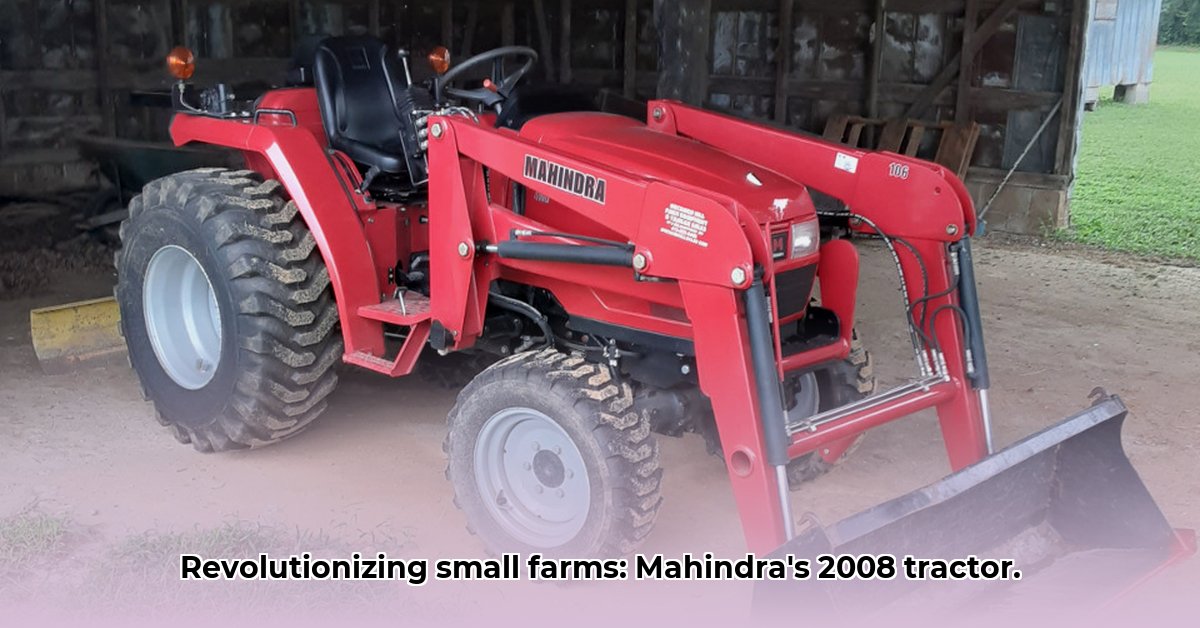
Assessing the Mahindra 2816's Role in Sustainable Agriculture
The Mahindra 2816 tractor, a prevalent sight on many smaller farms, presents a nuanced case study in sustainable agriculture. Its affordability and reliability have undeniably benefited numerous farmers, yet its technological limitations require careful consideration within the broader context of environmentally conscious farming practices. This analysis explores the Mahindra 2816's contributions and shortcomings, offering insights for farmers and policymakers alike. For more information on Mahindra tractors, see Mahindra Tractor Makers.
Affordability and Accessibility: A Foundation for Sustainable Practices
The Mahindra 2816's initial affordability significantly impacted smallholder farmers, many of whom previously lacked access to mechanization. This access, however, is only a piece of the puzzle. Reduced reliance on manual labor, a major driver of the tractor's adoption, directly translates into improved efficiency and worker well-being—both key elements of sustainable farming. But how does this translate to long-term sustainability? This initial cost advantage must be weighed against the tractor's operational costs and long-term maintenance needs.
Reliability and Lower Operational Costs: A Crucial Factor in Sustainability
Farmers frequently cite the Mahindra 2816's reliability as a major strength. Fewer breakdowns mean reduced downtime and lower operational costs—a significant advantage in sustainable agriculture where every saved dollar can be reinvested in improving farm practices. This reliability, however, doesn't negate the need for regular maintenance and the potential for eventual component failures. What are the most common points of failure, and what is the long-term cost of parts replacement? This data needs further investigation. Is the long-term cost of keeping a 2008 model running more or less sustainable than switching to a newer model?
Technological Limitations and the Need for Precision Agriculture
The Mahindra 2816 lacks the advanced features (GPS-guided steering, automated controls) found in newer tractors. These features are increasingly important for precision agriculture, a cornerstone of sustainable practices. Precision agriculture allows for optimized resource utilization, minimizing waste and reducing the environmental footprint of farming. The absence of such technology in the 2008 model limits its potential for resource efficiency. How significant is this limitation, and can supplementary practices mitigate the impact? This requires a detailed analysis of the tractor's capabilities versus the need for precision in various cropping systems.
Three Pivotal Points:
- The Mahindra 2816's initial low cost made mechanization accessible to many smallholder farmers, boosting efficiency.
- Its reliability minimizes downtime, contributing to lower operational costs.
- The lack of advanced technologies limits its potential for precision agriculture, hindering optimal resource utilization.
Fuel Efficiency and Environmental Impact: A Missing Piece of the Puzzle
Data on the Mahindra 2816's fuel consumption and emissions are limited. While anecdotal evidence suggests reasonable fuel economy for its class, a comprehensive assessment of its environmental impact remains elusive. This lack of readily available data is a major obstacle in fully evaluating its role within the framework of sustainable agriculture. What research is underway to quantify its fuel efficiency and greenhouse gas emissions in various operating conditions? This is a critical area needing further investigation.
Adapting to a Changing Landscape: The Path Forward
To remain a viable option for sustainable farming, the Mahindra 2816 requires ongoing improvements and a broader ecosystem of support. Manufacturers must invest in enhancing fuel efficiency, reducing emissions and integrating precision agriculture technologies. Furthermore, governments and NGOs can play a vital role by providing subsidies for sustainable farming technologies, access to parts and affordable maintenance services. Investing in farmer education and skill-building is crucial to ensure that this technology is both utilized effectively and to its full potential to improve sustainability.
"The Mahindra 2816's role in sustainable agriculture isn't simply about the tractor itself; it's about the entire system," says Dr. Anya Sharma, Agricultural Economist at the University of Delhi. "Access to technology, farmer education, and supportive policies are all essential components."
How to Evaluate the Mahindra 2816's Sustainability in Your Specific Farming Context
The Mahindra 2816's suitability for sustainable farming is highly context-dependent. Factors such as farm size, soil type, crop choices, climate, and available resources all play critical roles. To make an informed decision, farmers should undertake a comprehensive evaluation process.
Steps for Evaluating Sustainability:
- Assess your farm's specific needs: What tasks will the tractor primarily perform? What are the soil conditions and climate factors?
- Compare fuel consumption: Document the Mahindra 2816's fuel consumption against modern alternatives, standardizing data for accurate comparison.
- Evaluate total cost of ownership: Factor in purchase price, maintenance, repairs, fuel costs, and potential resale value.
- Consider environmental impacts: Assess greenhouse gas emissions, noise pollution, and potential soil compaction.
- Analyze the broader farming system: Evaluate how the tractor integrates with other inputs, adopting sustainable practices like no-till farming, cover cropping, and crop rotation.
By following these steps, farmers can make an informed decision about whether the Mahindra 2816 aligns with their sustainability goals and operational needs. Remember, sustainable farming is a holistic approach, not simply about the choice of machinery.